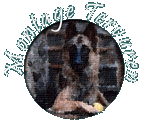|
Thrym was xrayed at 36 months old for his official OFA ratings. Most unfortunately, OFA rated him as dysplastic in both hips and both elbows.
This came as a devastating surprise as he had been xrayed completely clear for hip and elbow dysplasia at 16 months old. At that time (July 2005) there were no signs at all
of dysplasia in his hips or elbows. Based on these preliminary evaluations, he was allowed to sire one litter of 5 males -- the Gangsters. --
as the dam was advancing in age and it was her only chance to breed to him. According to OFA statistics, xrays done between 12-23 months of age are highly predictive 75-95% of the time,
with the higher percentages as you get closer to 24 months. Thrym's case is unusual in that his hips changed dramatically after his prelims, and there were no telltale indicators of trouble
ahead. The dam of the Gangster litter had good hips and elbows, as well as a great track record for healthy puppies. The structure of Thrym's hip joints caused him discomfort and this is
certainly a compelling reason to always wait until at least 2 years old before doing OFA clearances.
OFA INFORMATION
A publication by OFA -- www.offa.org/monograph2006web.pdf --
has a section on "The effect of age and the use of preliminary radiographs for early detection of hip dysplasia" (Page 25)
that may help explain why Thrym's hips and elbows seemed normal (passing) at 16 months of age on his preliminary evaluations, but were not when repeated at 36 months of age.
The OFA info page has links to more good articles. I also recommend the web site of the
International Elbow Working Group. They are considered the authorities on Elbow Dysplasia. IEWG recommends two
radiographic views of the elbows, a more accurate evaluation system than OFA. Many veterinary orthopedists and radiologists question the accuracy of OFA's elbow rating system,
as it does not take into consideration joint changes due to normal wear and tear, prior injury or trauma, and diet/nutrition effects. Many experts feel OFA's elbow rating system
has a statistically significant margin of error, erroneously labeling some changes as hereditary. The only way to definitively diagnose whether or not elbow changes are due to hereditary
factors versus external factors is a CT scan. This gold standard of diagnostic methods is out of most people's price range at $1500-$2500, and is usually available only at major veterinary hospitals.
Return to Thrym's Main Page
|



